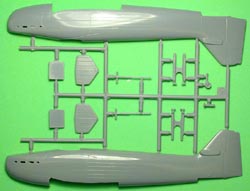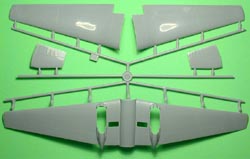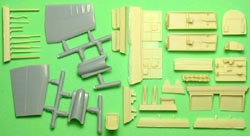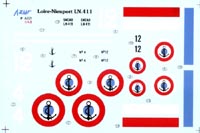Azur's 1/48 Loire-Nieuport LN 411
By Chris Banyai-Riepl
 |

 |
 The LN401/411 saw service in the opening days of the Second World War, where its shortcomings quickly became apparent. In one attack against a crossroads, 20 planes attacked, with a result of 10 being shot down and limited damage on the crossroads. The LN401/411s were then relegated to flying reconnaissance missions over the Italian coast until the capitulation of France, after which the remaining 15 planes flew to North Africa. Production was terminated when the Germans occupied the factory, and the LN401/411 faded into obscurity.
The LN401/411 saw service in the opening days of the Second World War, where its shortcomings quickly became apparent. In one attack against a crossroads, 20 planes attacked, with a result of 10 being shot down and limited damage on the crossroads. The LN401/411s were then relegated to flying reconnaissance missions over the Italian coast until the capitulation of France, after which the remaining 15 planes flew to North Africa. Production was terminated when the Germans occupied the factory, and the LN401/411 faded into obscurity. Back in 1999 when Azur first came out with their 1/72 kit of this plane I thought to myself 'man, this is a rather ugly little plane!', and now that it's been released in 1/48 I've been able to look at it a bit closer in this larger scale. Well, it's still a rather ugly little plane, but at least this kit of it is very well done. You get a handful of medium gray plastic parts, all with recessed panel lines and crisp molding. In addition to this you also get a handful of tan resin parts and a couple vacuformed canopies. A nice decal sheet adds color to this otherwise mundane aircraft.
Back in 1999 when Azur first came out with their 1/72 kit of this plane I thought to myself 'man, this is a rather ugly little plane!', and now that it's been released in 1/48 I've been able to look at it a bit closer in this larger scale. Well, it's still a rather ugly little plane, but at least this kit of it is very well done. You get a handful of medium gray plastic parts, all with recessed panel lines and crisp molding. In addition to this you also get a handful of tan resin parts and a couple vacuformed canopies. A nice decal sheet adds color to this otherwise mundane aircraft. Now if you're wondering if this is just a scale-up of their earlier 1/72 kit, rest assured it is not. Several of the areas that I found problems with in that smaller release are alleviated with this one, and you get much more detail to boot. The cockpit is a very nice resin affair, with separate sidewalls and rear bulkhead provided. The seat, control column and instrument panel round out the innards and it all will look great under paint. Then you get to stick it in the fuselage, and with that tiny cockpit opening not much of this detail will be visible, even with the canopy open.
Now if you're wondering if this is just a scale-up of their earlier 1/72 kit, rest assured it is not. Several of the areas that I found problems with in that smaller release are alleviated with this one, and you get much more detail to boot. The cockpit is a very nice resin affair, with separate sidewalls and rear bulkhead provided. The seat, control column and instrument panel round out the innards and it all will look great under paint. Then you get to stick it in the fuselage, and with that tiny cockpit opening not much of this detail will be visible, even with the canopy open. The fuselage has individual openings for the exhaust stacks, which are included in cast resin. The biggest difference between the 1/72 and 1/48 kits has to do with the wings, and in this case I have to say that the 1/48 kit wins hands-down. The lower wing is molded as one piece and includes a piece of the lower fuselage, with separate upper wing halves. No butt joints here! The wheel wells get resin inserts, as do the radiators in the lower wing & trailing edge. This was a very troublesome area on the 1/72 kit and I'm glad to see Azur handling it this way on this bigger release.
The fuselage has individual openings for the exhaust stacks, which are included in cast resin. The biggest difference between the 1/72 and 1/48 kits has to do with the wings, and in this case I have to say that the 1/48 kit wins hands-down. The lower wing is molded as one piece and includes a piece of the lower fuselage, with separate upper wing halves. No butt joints here! The wheel wells get resin inserts, as do the radiators in the lower wing & trailing edge. This was a very troublesome area on the 1/72 kit and I'm glad to see Azur handling it this way on this bigger release. The rest of the construction is pretty straightforward, with the tailplanes molded solid and butt-joining to the fuselage. The outboard vertical pieces are also molded as one piece and again join flush up against the stabilizers. These would probably best be pinned with fine wire to help with alignment and strength. The landing gear on this plane is beefy in real life, and this kit does a good job of replicating it. You might want to thin down the wheel doors, but other than that you should have some good legs to set this bird on.
The rest of the construction is pretty straightforward, with the tailplanes molded solid and butt-joining to the fuselage. The outboard vertical pieces are also molded as one piece and again join flush up against the stabilizers. These would probably best be pinned with fine wire to help with alignment and strength. The landing gear on this plane is beefy in real life, and this kit does a good job of replicating it. You might want to thin down the wheel doors, but other than that you should have some good legs to set this bird on. The decal options provide a couple of choices, both finished in the French three-color upper camouflage of khaki, brown and blue gray over light blue gray. Both are French Navy birds, complete with roundels with anchors. The first one has a white 12 on the fuselage side, while the second carries a white 4 and has a rather large white outline around the fuselage roundels. The decals are printed by Propagteam and are thin and in perfect register.
The decal options provide a couple of choices, both finished in the French three-color upper camouflage of khaki, brown and blue gray over light blue gray. Both are French Navy birds, complete with roundels with anchors. The first one has a white 12 on the fuselage side, while the second carries a white 4 and has a rather large white outline around the fuselage roundels. The decals are printed by Propagteam and are thin and in perfect register.